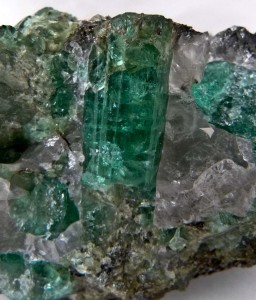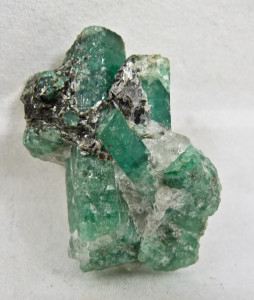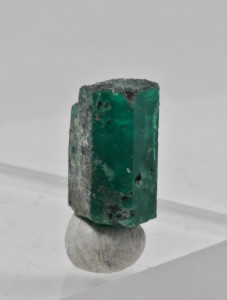 Emerald is a very rare stone and only forms under very special geological conditions that enrich beryl in chromium. Typically, this type of environment is found at or near the contact between a felsic igneous rock such as a granite and a chromium rich ultramafic rock such as serpentinite. The contact of these two rock types creates fluid exchange, which often form hydrothermal veins that contain emerald. Emerald in these hydrothermal veins is associated with calcite, quartz, biotite, pyrite, euclase, apatite, and other minerals. Some emerald locations produce crystals from pegmatites or from tin-tungsten-molybdenum rich hydrothermal veins. The emerald locations in North Carolina are extremely unique in that emerald is found in association with lithium mineralization- particularly the green gem variety of spodumene- hiddenite.
Emerald is a very rare stone and only forms under very special geological conditions that enrich beryl in chromium. Typically, this type of environment is found at or near the contact between a felsic igneous rock such as a granite and a chromium rich ultramafic rock such as serpentinite. The contact of these two rock types creates fluid exchange, which often form hydrothermal veins that contain emerald. Emerald in these hydrothermal veins is associated with calcite, quartz, biotite, pyrite, euclase, apatite, and other minerals. Some emerald locations produce crystals from pegmatites or from tin-tungsten-molybdenum rich hydrothermal veins. The emerald locations in North Carolina are extremely unique in that emerald is found in association with lithium mineralization- particularly the green gem variety of spodumene- hiddenite.
Most of the world’s emerald supply is from Colombia, particularly from the numerous mines in the Boyaca Department. These mines pursue hydrothermal veins of calcite rich in gem emerald crystals. Specimens that do not get cut often show beautiful prismatic emeralds, often with many extra faces perched on a matrix of calcite, pyrite, and occasionally other minerals as well. These emerald deposits are associated with other rare and valuable minerals- the two most famous being blue euclase and pink apatite. Some of the Colombian emeralds form unusual trapiche twins and occasionally replace fossils. The world’s largest emerald, weighing in at 7,025 carats was found in Colombia. In South America, emerald has also been found in a Biotite Schist in Bahia, Brazil that is mined on a smaller scale for gem material. The Bahian emeralds are of lesser quality though form larger crystals, which have been reported as weighing more than a kilogram.
 Africa is the second largest producer of emerald, the Kagem Mine in Zambia producing most of the continent’s export. The Kagem Mine is the world’s single largest emerald mine- it occupies a square kilometer of land. This mine works emerald bearing quartz zones in a biotite schist. A huge 6225 carat emerald called ‘Insofu’ was found here in 2010. Nigeria, Mozambique, and Madagascar have also produced numerous emeralds. The latter two produce vanadium rich varieties at some locations that have a strong lagoon blue color.
Africa is the second largest producer of emerald, the Kagem Mine in Zambia producing most of the continent’s export. The Kagem Mine is the world’s single largest emerald mine- it occupies a square kilometer of land. This mine works emerald bearing quartz zones in a biotite schist. A huge 6225 carat emerald called ‘Insofu’ was found here in 2010. Nigeria, Mozambique, and Madagascar have also produced numerous emeralds. The latter two produce vanadium rich varieties at some locations that have a strong lagoon blue color.
Emerald has also been found in the US at several locations- North Carolina, Montana, Nevada, and Connecticut. North Carolina produces the finest quality emerald specimens in the country and are unusual for their association with smoky quartz, rutile, phlogopite, ankerite, and green spodumene, known as hiddenite. North Carolina emerald shows a moderate to dark color saturation similar to material from Colombia. North Carolina is actively mined for emeralds on a small term basis, which are highly collectable due to rarity.

Russian emerald is rare but important to mention for two reasons- specimens of this high quality material are valuable classics, and they are found with many other gem minerals such as alexandrite and euclase. Malyshevo, the region of the Urals known to produce fine emeralds is also the type locality of the well known mineral Phenakite, which occurs with the emeralds in a biotite schist.
Emerald has also been found in recent times at locations in South Africa, China, Australia, Pakistan, Afghanistan, Norway, Austria, and Spain though these sites are far more minor occurrences than the others mentioned above though moreso in terms of quantity of material versus quality.
